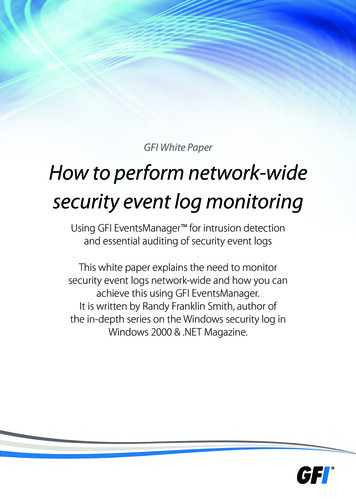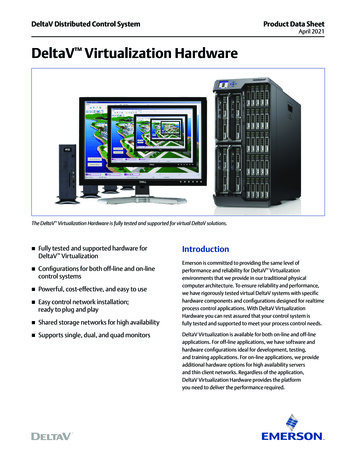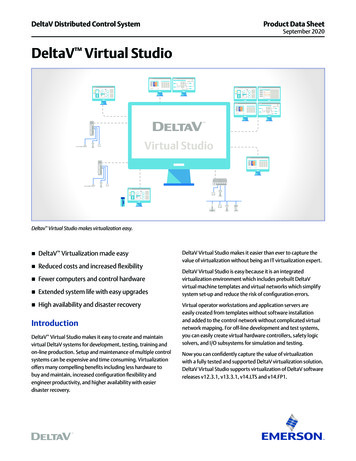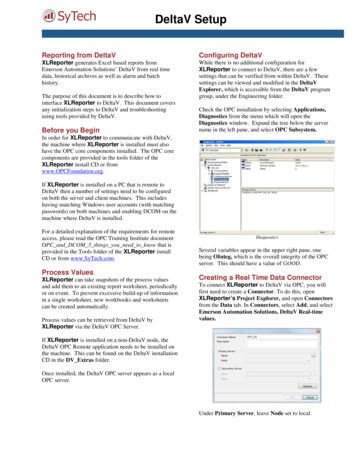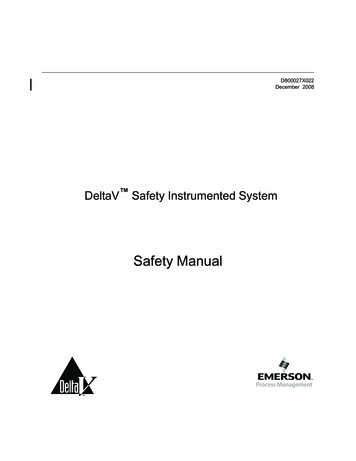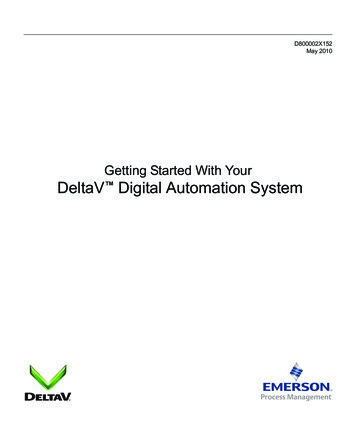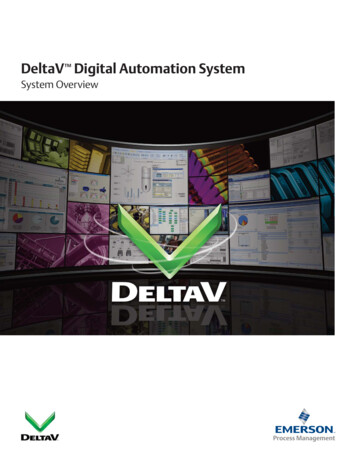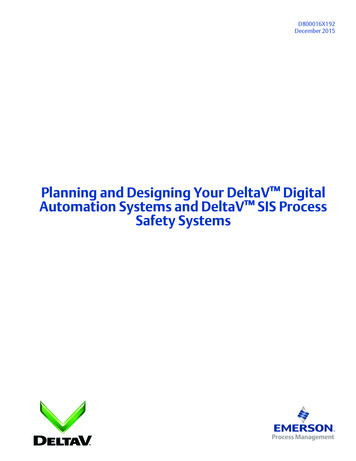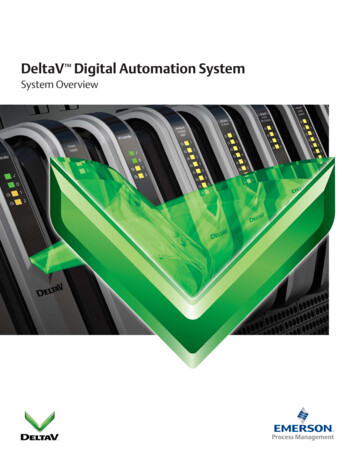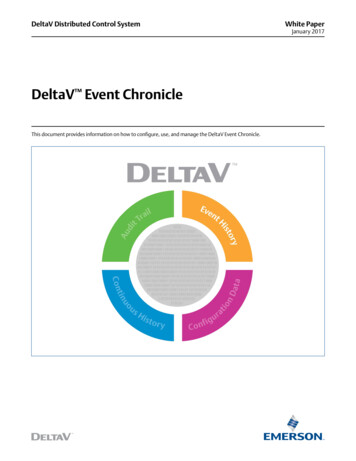
Transcription
DeltaV Distributed Control SystemDeltaV Event ChronicleThis document provides information on how to configure, use, and manage the DeltaV Event Chronicle.White PaperJanuary 2017
DeltaV Event ChronicleJanuary 2017Table of ContentsIntroduction . 3Database Technology . 3Database Architecture . 3Configuration . 4Workstation Configuration . 4Database Configuration . 6Viewing Data .10Process History View .10Batch History View .12Batch Historian .12DeltaV Analyze .12Database Management . 13Event Chronicle Administration Utility .13Troubleshooting . 21Event Chronicle Diagnostics . 21Microsoft SQL Server Database Management Utility . 22Power Failure . 23Performance . 23Licensing Requirements . 24Event Chronicle Migration . 24www.emerson.com/deltav2
DeltaV Event ChronicleJanuary 2017IntroductionAn event is any noteworthy occurrence in your process or system that you want the system to react to and record. Events that arebrought to the operator’s attention are alarms. Along with standard alarms and events, the DeltaV system provides the means forusers to easily create their own specific alarms and events.The DeltaV system provides an event historian to capture the process alarms, events, log messages and user actions generatedby the system. The event historian also captures safety related alarms, events, log messages and user actions generated byDeltaV SIS. The event historian may also capture batch events generated by DeltaV Batch. High resolution events and logmessages generated by the DeltaV Sequence of Events (SOE) card are also captured in the event historian. The event historian iscalled the Event Chronicle. The Event Chronicle database stores process, safety, batch and SOE alarm and event data in event historydata sets. Process History View is the DeltaV application used to view, query, and analyze the alarms and events captured in theEvent Chronicle.You determine which workstations maintain an active Event Chronicle database and the areas for which the workstation collectsthe events. The DeltaV ProfessionalPLUS, Operator Stations, and Application Stations are each capable of collecting alarm and eventdata in their local Event Chronicle.Each DeltaV workstation has an Alarms and Events subsystem which is used for managing alarms and events. You assign areasto the Alarms and Events subsystem on the DeltaV workstation. The alarms and events generated in these areas are captured inthe local Event Chronicle. It is practical to collect alarms and events for the areas that match the operator span of control on eachworkstation. System-wide events such as logins, logouts, and downloads are always associated with AREA A in a DeltaV system.This means that AREA A must be assigned to the Alarms & Events subsystem in order for those types of events to be recorded. Atthe same time, it may also be helpful to set up the ProfessionalPLUS or Application Station to record the alarms and events for theentire system. This enables operators to query records across all areas when necessary.Database TechnologyThe Event Chronicle was initially released with a Microsoft Jet database engine. The Jet database is the same database used byMicrosoft Access. The MS Jet based Event Chronicle was available in the DeltaV system up to the v8.x release. The original EventChronicle created a single Jet database file, EJournal.mdb, which was limited to a maximum of 500,000 records.In DeltaV v9.3 and later releases, the Event Chronicle uses a Microsoft SQL Server database engine. The current Event Chronicleis capable of creating multiple user-configurable SQL database files, each capable of holding from approximately 300,000 recordsup to 14,000,000 records, providing greater on-line storage capacity.Database ArchitectureThe SQL based Event Chronicle stores events in event history data sets. The storage capacity of each event data set and the totalsize consumed by the data sets are user-configurable by file size or time duration. There are three types of event history data sets,Active, Current, and Extended.The Active data set contains the most recent event records for the associated Event Chronicle. In MS SQL Server terminology, theActive data set is the main database. There is one Active event history data set in each Event Chronicle.The Current data sets contain events that the system has copied from the Active data set. In MS SQL Server terminology, a Currentdata set is an attached archive. There can be any number of Current data sets in the Event Chronicle, subject to only to the Currentdata set total storage target (as discussed below).The Extended data sets are created from Current data sets that have been exported from the Event Chronicle. In SQL Serverterminology, creating an Extended data set is reattaching a detached archive. There can be multiple Extended data sets in the EventChronicle. The number is limited only by the amount of available disk space. Note Extended data sets do not count against theCurrent data set total storage target.www.emerson.com/deltav3
DeltaV Event ChronicleJanuary 2017Event history data sets can be exported from one Event Chronicle and imported into another Event Chronicle as an Extended dataset, within the same system.DeltaV Workstationwith Event ChronicleDeltaV Workstationwith Event ChronicleDeltaV Workstationwith Event ChronicleDeltaV Workstationwith Event ChronicleFigure 1 – Sample DeltaV system with an Event Chronicle licensed and enabled on every DeltaV workstation.ConfigurationIt is easy to configure alarm and event collection in the DeltaV system. The alarm and event collection can be separated into twoactivities, workstation configuration and database configuration.Workstation ConfigurationWorkstation configuration begins with assigning areas to the Alarms and Events subsystem on the workstation. As mentioned in theIntroduction, it is practical to collect alarms and events for the areas that match the operator span of control on each workstation.System-wide events such as logins, logouts, and downloads are always associated with AREA A in a DeltaV system. In DeltaVExplorer, simply drag and drop the areas of interest onto the Alarms and Events subsystem on the associated workstation. Note thatAREA A is assigned to the workstation by default.Figure 2 shows DeltaV Explorer with the workstation’s Alarms and Events subsystem highlighted.www.emerson.com/deltav4
DeltaV Event ChronicleJanuary 2017Figure 2 – Alarms and Events subsystem.The second step of workstation configuration is to enable the Alarms and Events subsystem on the workstation. The Alarms andEvents subsystem is enabled from the General tab of the Alarms and Events Properties dialog, accessed from DeltaV Explorer byright-clicking the Alarms and Events subsystem on the workstation. Note the Alarms and Events subsystem on the ProfessionalPLUSworkstation is enabled by default.Figure 3 shows the General tab in the Alarms and Events Properties dialog. This dialog shows the Event Chronicle is enabled andconfigured as the System SOE Collector.Figure 3 – Alarms and Events Properties dialog general tab.www.emerson.com/deltav5
DeltaV Event ChronicleJanuary 2017Optionally, the Event Chronicle can be enabled as the System SOE Collector. The System SOE Collector captures log messagesand events from Sequence of Events discrete input cards. By default, the Event Chronicle on the ProfessionalPLUS Station isconfigured as the System SOE Collector. If you want these events collected in a different workstation, open the Events and AlarmsProperties dialog for that workstation and click the System SOE Collector box. Only one workstation can be designated as theSystem SOE collector.Changes to the assigned areas and enabling/disabling the Alarms and Events subsystem require a workstation download.The order of workstation configuration is not important – you can enable the Alarms and Events subsystem before you assignthe areas. However, you must complete both steps and download the changes before the Event Chronicle starts to collect alarmsand events.Database ConfigurationThe SQL Server based Event Chronicle has greater functionality than the original Jet based Event Chronicle, which requiresslightly different configuration options. In the original Jet based Event Chronicle, you configured when to perform the databasemaintenance cycle, the size of the database (in number of days), the export behavior, and the maximum number of event records.In the SQL Server based Event Chronicle, you configure the Active data set size target (in MB), the time duration for copying alarmsand events from the Active to the Current data set, the Current data set size target (in MB or time duration), the Current data settotal storage target (in MB), and the export behavior. In the SQL Server based Event Chronicle, the database maintenance cycle isperformed continually, so there is no need to specify when to run the maintenance cycle.The Event Chronicle database is configured from the Advanced tab of the Alarms and Events Properties dialog, accessed fromDeltaV Explorer by right-clicking the Alarms and Events subsystem on the workstation. The Alarms and Events Properties Advancedtab includes the following sections for setting the database configuration options.Figure 4 shows the Advanced tab in the Alarms and Events Properties dialog. The individual sections of this dialog aredetailed below.Figure 4 – Alarms and Events Properties dialogadvanced tab.www.emerson.com/deltav6
DeltaV Event ChronicleJanuary 2017Active Event History Data Set Storage: The Active data set contains the most recent event records for the Event Chronicle. Thereis one Active data set in each Event Chronicle. The Active data set is managed by the Event Chronicle. The Active data set cannot bedeleted or backed up. To back up event records, at least one Current data set must be created, which allows event in the Active dataset to be automatically copied to a Current data set. Creation of Current data sets is detailed below.The storage target of the Active data set is user configurable from 100 MB to 4000 MB. The default storage target for the Activedata set is 100 MB. The Event Chronicle will allocate the configured disk space for the Active data set on creation of the Active dataset, even though the Active data set does not yet contain any event records.When the Active data set storage target is configured, the system allocates the user-specified disk space for the Active data set.When the Active data set approaches the target size, the system deletes the oldest event records in the Active data set to makeroom for new events. To retain these older event records, you must create at least one Current data set for the Active data set to useto copy event records. Creation of Current data sets is detailed below.NOTE: Decreasing the storage target of the Active data set requires a workstation restart.You also may configure the time duration for copying alarms and events from the Active data set to the most recent Current dataset. This value defines the age (in hours) at which events in the Active data set are replicated in the most recent Current data set.For example, if the value is 12 hours, then the alarms and events in the most recent Current data set will contain alarms and eventsthat are 12 or more hours old. It will not contain alarms and events that occurred within the last 12 hours. Since the Active dataset cannot be backed up or exported, this setting allows the most recent Current data set, which can be backed up or exported, tocontain nearly all the alarms and events in the Active data set. At least one Current data set must exist in order to use the copy eventrecords feature.The time range for copying event records to the most recent Current data set is 1 hour to 1000 hours. The default time duration is12 hours. The Event Chronicle transfers event records that meet the age requirement at the beginning of every hour.Figure 5 shows the Active data set storage configuration. The Active data set is configured at the default setting of 100MB. The agefor copying event records from the Active to the Current data set is configured at the default setting of 12 hours.Figure 5 – Active Event History Data Set Storage configuration.Current Event History Data Set Storage: The Current data sets contain alarms and events that the system has copied from theActive data set. Current data sets enable you to organize event records into manageable chunks for storage on off-line media. Youdefine the rules that the system uses to create data sets. You can set a target size and a calendar period for creating new Currentdata sets. For example, you might configure a data set to be approximately the size of a CD for convenient copying to opticalstorage. Or, you might configure the system to create a new data set at the start of each week.In general, Current data sets may be deleted, backed up, or exported. The most recent Current data set is unique in that it is the dataset that is receiving event records copied from the Active data set. The most recent Current data set may be backed up or exported,but it may not be deleted.The storage target of the Current data set is user configurable from 100 MB to 4000 MB. The default storage target for the Currentdata set is 100 MB. Note that changing this value only affects future data sets.www.emerson.com/deltav7
DeltaV Event ChronicleJanuary 2017The storage target for the Current data set can also be configured by time span. Daily, weekly, and monthly time spans are available.If time span is selected, new Current data sets are created at 12:00 am, local time. Thus, daily Current data sets are created each dayat 12:00 am; weekly Current data sets are created on Sunday at 12:00 am; and monthly Current data sets are created on the first dayof the month at 12:00 am.The Current data set time span setting is subject to the Current data set storage target. If the Current data set is configured for amonthly time span, and the default Current data set storage target is 100 MB, then a new Current data set will be created at thestart of a new month or when the Current data set reaches 100 MB, whichever comes first.The Current data set total storage target defines how much disk space is allocated to retaining Current data sets. To create Currentdata sets, the Current data set total storage target must be greater than 0 MB. If the Current data set total storage target is 0 MB,then no Current data sets will be created, regardless of whether the Current data set storage target or time span is configured.The Current data set total storage target is user configurable as 0 MB or from 100 MB to 50,000 MB. The default setting for theCurrent data set total storage target is 0 MB.NOTE: The default Current data set total storage target is 0 MB, meaning the default configuration does not create any Current datasets. To create Current data sets, the Current data set total storage target must be greater than 0 MB.When the Active data set approaches its target size, the system deletes the oldest event records in the Active data set. To retainthese older records, you must configure the Current data set total storage target to be at least as big as the Current data set storagetarget (100 MB or greater). If a Current data set is available, the event records in the Active data set should already exist in theCurrent data set prior to deletion.When the size of all the Current data sets reaches or exceeds the Current data set storage target, the Event Chronicle begins deletingthe oldest Current event history data sets until the available storage is within the target. If the event records in these older Currentdata sets are needed, you must manually export the oldest Current data sets using the Event Chronicle Administration Utility orconfigure the Event Chronicle for automatic export. The manual export and automatic export features are detailed below.The disk space used by the Active and Current data sets is called Primary Storage.Figure 6 shows the Current data set configuration. The Current data set is configured to collect data in weekly increments with adata set size target override configured to the default setting of 100MB. The Current event history data set total storage targetsetting was modified from the default of 0 MB to 500 MB. A Current data set total storage target of 500 MB will create five (5)Current data sets of 100 MB each.Figure 6 – Current Event History Data Set Storage configuration.www.emerson.com/deltav8
DeltaV Event ChronicleJanuary 2017Automatic Current Event History Data Set Export The Event Chronicle includes automatic data set export. Enabling automaticCurrent data set export copies Current data sets to the specified directory in order to s
The Event Chronicle database is configured from the Advanced tab of the Alarms and Events Properties dialog, accessed from DeltaV Explorer by right-clicking the Alarms and Events subsystem on the workstation. The Alarms and Events Properties Advanced tab includes the following
